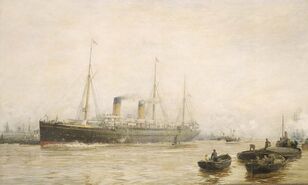 | |
| Type | Partnership |
|---|---|
| Headquarters | Liverpool, United Kingdom |
The Oceanic Steam Navigation Company or White Star Line of Boston Packets, more commonly known as just White Star Line, was a prominent British shipping company. Originally founded in 1845 as a fleet of clipper ships operating between Britain and Australia, it entered the Transatlantic passenger business in 1869. Among its most famous vessels include the innovative Oceanic of 1870 and the famous Olympic-class superliners.
History
Early History
The first company bearing the name White Star Line was founded in Liverpool, England, by John Pilkington and Henry Wilson in 1845. It focused on the UK–Australia trade, which increased following the discovery of gold in Australia. The fleet initially consisted of the chartered sailing ships RMS Tayleur, Blue Jacket, White Star, Red Jacket, Ellen, Ben Nevis, Emma, Mermaid and Iowa. Tayleur, the largest ship of its day, wrecked on its maiden voyage to Australia at Lambay Island, near Ireland, a disaster that haunted the company for years.
In 1863, the company acquired its first steamship, the Royal Standard.
The original White Star Line merged with two other small lines, The Black Ball Line and The Eagle Line, to form a conglomerate, the Liverpool, Melbourne and Oriental Steam Navigation Company Limited. This did not prosper and White Star broke away. White Star concentrated on Liverpool to New York services. Heavy investment in new ships was financed by borrowing, but the company's bank, the Royal Bank of Liverpool, failed in October 1867. White Star was left with an incredible debt of £527,000 (£41,675,946 as of 2016), and was forced into bankruptcy.
On January 18, 1868, Thomas Ismay, a director of the National Line, purchased the house flag, trade name and goodwill of the bankrupt company for £1,000 (£80,358 as of 2016), with the intention of operating large ships on the North Atlantic service between Liverpool and New York. Ismay established the company's headquarters at Albion House, Liverpool.
Ismay was approached by Gustav Christian Schwabe, a prominent Liverpool merchant, and his nephew, shipbuilder Gustav Wilhelm Wolff, during a game of billiards. Schwabe offered to finance the new line if Ismay had his ships built by Wolff's company, Harland and Wolff. Ismay agreed, and a partnership with Harland and Wolff was established. The shipbuilders received their first orders on July 30, 1869. The agreement was that Harland and Wolff would build the ships at cost plus a fixed percentage and would not build any vessels for the White Star's rivals. In 1870, William Imrie joined the managing company. As the first ship was being commissioned, Ismay formed the Oceanic Steam Navigation Company to operate the steamers under construction.
It has long been customary for many shipping lines to have a common theme for the names of their ships. White Star gave their ships names ending in -ic, such as Titanic. The line also adopted a buff-colored funnel with a black top as a distinguishing feature for their ships, as well as a distinctive house flag, a red broad pennant with two tails, bearing a white five-pointed star.
The first substantial loss for the company came only four years after its founding, occurring in 1873 with the sinking of the SS Atlantic and the loss of 535 lives near Halifax, Nova Scotia. While en route to New York from Liverpool amidst a vicious storm, the Atlantic attempted to make port at Halifax when a concern arose that the ship would run out of coal before reaching New York. However, when attempting to enter Halifax, she ran aground on the rocks and sank in shallow waters. Despite being so close to shore, a majority of the victims of the disaster drowned. The crew were blamed for serious navigational errors by the Canadian Inquiry, although a British Board of Trade investigation cleared the company of all extreme wrongdoing.
During the late nineteenth century, White Star operated many famous ships, such as the Britannic (1874), the Germanic, the Teutonic, and the Majestic (1890). Several of these ships took the Blue Riband, awarded to the fastest ship to make the Atlantic crossing.
In 1899, Thomas Ismay commissioned one of the most beautiful steamships constructed during the nineteenth century, the Oceanic (1899). She was the first ship to exceed the Great Eastern in length (although not tonnage). The building of this ship marked White Star Line's departure from competition in speed with its rivals. Thereafter White Star concentrated on comfort and economy of operation instead.







